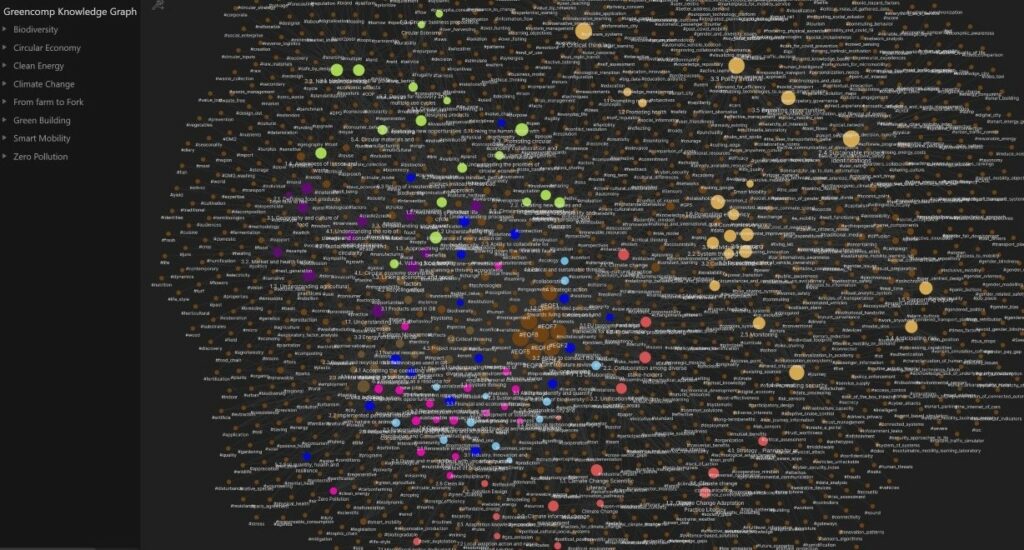Competence framework: a first, fundamental draft for the key element of GreenSCENT
Lorenzo Colantoni (Uninettuno) – 6th of October 2022

In the past few months, the Uninettuno team, supported by GreenSCENT consortium, has significantly advanced in the definition of the core elements of the GreenSCENT project: the competence framework. Through literature review, original analysis and the use of advanced knowledge processing tools, the team drafted the first release of the competence framework, enabling the next phases of the project.
The competence framework is indeed the key element of GreenSCENT: generally speaking, it is a structure describing competences, knowledge, skills and attitudes citizens must know or be able to do in order to perform a task or understand a set of information. In the case of GreenSCENT, the framework concerns all the elements needed by European citizens to understand the eight areas of the Green Deal: Climate Change, Clean Energy, Circular Economy, Green Buildings, Smart Mobility, From Farm to Fork, Biodiversity and Zero pollution. The scope is ultimately to define the fundamental information and abilities on these topics that must be held by all the European citizens, from all member states and from all qualifications – including primary and secondary school students, young professionals, PhD students. The work done aims to expand the conceptual Sustainability Framework already developed by the Joint Research Center, providing a more operational and detailed descriptions focusing on the above mentioned 8 focus areas of the European Green Deal.
The work of the different teams responsible for each area has been multi-layered: they had to first identify a set of competence areas (usually 3 or 4), which generally defines the core elements of the topic – in the case of Farm to Fork this was “sustainable food production” or “food loss and waste prevention”, for instance. Each competence area has been then detailed into another set of specific competences (“understanding natural processes” or “understanding agricultural practices”, for example) and then further specified into a Knowledge-Skills-Attitudes (KSA) matrix – i.e. the information each citizen is expected to hold, the abilities she or he should achieve and the habits she or he should develop on the topic. Such a pyramid structure has the scope of turning a theoretical framework into action, answering the question: what should European citizens know and be able to do to fully grasp the complexity of the Green Deal?
The process has been equally complex: the teams started from literature review, trying to identify what has been done so far on the topics, obtaining mixed results – some areas have been covered by such exercises in the past (climate change), but others are mostly new to competence frameworks (Farm to Fork). The next step has been thus to synthetise what was found, and to produce original content for the parts that were missing. This task was achieved through a variety of research, including the review of EU strategies and reports. At the end of the summer, a final draft with almost forty competence areas and tens of competences and KSAs was finally delivered.
The team went one step ahead, though; considering the complexity of the structure, the team decided to adopt the Obsidian software to ease the understanding of the connections between the different competences through a series of Knowledge Graphs. The software indeed allows for the creation of a “spatial constellation” – i.e. a series of lines connecting competences sharing the same keywords. This also favours the discovery of new links between areas, highlighting the connections between the different topics touched by the Green Deal.
Despite all this work, the competence framework is still far from finished. The next step will foresee the validation of the whole set of competence areas, competences and KSAs through a series of initiatives, pedagogical activities and demonstrators, involving the use of digital and hybrid technologies and the participation of young European citizens, to verify the accuracy of the proposed framework. Again, the scope will be to turn such an abstract set of information into a practical tool supporting course and curriculum design and skill assessment, that will fit the needs of the European citizens, schools, universities, enterprises and institutions, and which will hopefully become a fundamental tool in the years to come.

3 thoughts on “Competence framework: a first, fundamental draft for the key element of GreenSCENT”
Comments are closed.